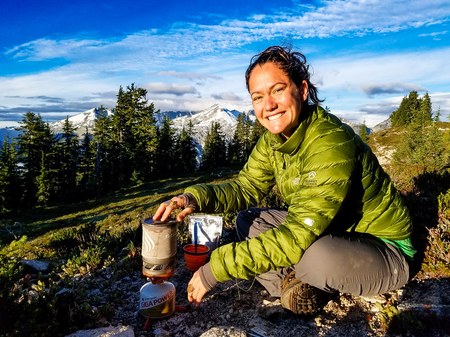
Backpacking provides isolation, time away from the stresses of work and home, and a window into the natural world. However, there is one element of backpacking that’s incongruent with its value set: trash.
Compared to most folks’ at-home habits, backpacking creates an incredible amount of trash. Trail mix, granola bars, dehydrated meals, single-serving coffee packs, and energy gels are vacuum packed and plastic wrapped to perfection, all of which goes into the landfill when you get home. Backpacking is inherently inconvenient – you’re forced to bring all of your necessities in a single pack, a much smaller space than the house you’re accustomed to filling up and living in. Sacrifices are made to get that drawstring tight, and among those is often the kind of foods we eat and the way we package them.
However, convenience shouldn’t triumph over responsibility, especially in the backcountry. Read on for tips to reduce the amount of plastic you produce on the trail while creating an enviable food plan.
Make and Dehydrate Your own Meals
Making and dehydrating your own food is far less convenient than a pre-packaged dehydrated meal, but many people cook their meals at home already. Instead of an inconvenience, view this as one additional step beyond your usual food prep. In addition to avoiding plastic wrap, you’re also creating meals that will cost less and likely be better for you than dehydrated meals designed for lengthy shelf lives.
You can dehydrate most foods in your oven at home – read up on the process here. You can mix dehydrated ingredients together to prep a meal, or cook it at home then dehydrate it. To start, check out these recipes for bulger chili, beef and barley stew, and 3 mushroom risotto. Dirty Gourmet also has a wealth of information on dehydrated camp meals, including this coconut curry soup.
You can also make your own granola bars. It's one of the easier foods to prep, and allows you to choose exactly what you want in your pack. Most bars are high in sugar and missing ingredients like flax seeds, sunflower seeds, or dried coconut. Granola requires only a handful of ingredients and an oven, and you have your trip snack ready to go.
Choose Reusable Packaging
Reusable packaging is the most obvious solution to the issue of excess trash, but also one of the more difficult ones to execute. In most of our kitchens we have two options for storage: Tupperware or ziplock bags. The former is not pack friendly, and the latter is often flimsy and good for a handful of light uses at most. This means that you’ll have to invest in new types of storage. The size and cost may seem like an unnecessary encumbrance, but you’ve probably bought and brought along one or two additional things on the trail - one more accommodation won’t hurt.
For dry goods, tightly woven cloth bags with drawstrings are great. Trail mix, beef jerky, granola, and dehydrated veggies will all do well in a cloth bag tied up neatly. It will accumulate crumbs inside that will need to be washed out, but they will serve you well and last for years if you treat them well. Purchase your cloth bags online, at craft stores, or repurpose other items from around the house. Remember the stuff sack that came with your puffy? It doubles as a granola bag.
If your trip is long enough (or wet enough) that moisture and rot are potential issues, grab a large reusable plastic bag to seal your dry goods in.
For your homemade dehydrated meals, bring along a few silicone resealable bags. Silicone is more environmentally friendly than plastic and has a higher heat tolerance, which allows you to treat it like a mountainhouse meal and pour boiling water straight in. Purchase the 'stand up' version to make the process easy on yourself.
No More Single-Serving Products
We all have our convenient go-to choices for backpacking, but many of these products are available in larger quantities that require less plastic per serving. Skip the single-serving packets and pick up a jar of instant coffee, grab the mega bag of beef jerky, and surf online for substitutes for your more unique single-serving foods. You can even find big packs of energy gel, seen here at Running Warehouse.
An even better option is getting foods in bulk. Grab jars from around the house and go pick up your nuts, berries, and grains from a store with a bulk section. Trail mix is the easiest thing to put together. Not only are you saving plastic, you can choose exactly what you do and don’t have to eat. No more pawning off Brazil nuts on your less particular trail partners.
For the Pros
If you backpack often and have the funds, space, and inclination to invest in additional gear, you may want to consider purchasing tools to make your dehydrated meal prep faster and smoother. This will not only encourage you to take those extra steps prior to a backpacking trip, but will also decrease the risk of over-dehydration and make the food that you do prep last longer. This added shelf life means that you could prep meals months in advance of your trip, or store leftovers until next season.
Food Dehydrator
A big step up from an oven, a good dehydrator can take a lot of the guesswork out of prepping food. Many dehydrators come with timers, allowing you to leave the house or leave it on overnight without concern. The cost range is significant, so be sure to research which features are most important to you and which you can live without to avoid over paying. If you’re unsure of how a dehydrator would fit into your routine, check out this guide on dehydrating to get a stronger idea of the process.
Vacuum Sealer
The best way to keep food dry and air-tight, vacuum packers are part of every serious food saver’s arsenal. It can be used to store dehydrated food for years, as well as meat and other goods you want to save from freezer burn – maybe following a fishing trip or a holiday with too many leftovers. There is a wide variety of reusable vacuum seal bags, and starter vacuum sealers are fairly inexpensive. This tool has a variety of uses outside your trip’s food prep, helping to mitigate any guilt you feel for buying yet another piece of backpacking-related gear.
Although it’s hard to add one more element to an already lengthy trip prep plan, taking steps to decrease your trash production on the trail is a great way to continue your efforts to protect and maintain the outdoors. Environmental stewardship doesn’t start at the trailhead, and it’s important that we continue to practice and prioritize it even when it’s inconvenient. Many of these habits can also be incorporated into your normal routine, like shopping in bulk and saving food in resealable containers. Taking your time and being thoughtful about your backpacking food prep will not only improve your on-trail dining, but help protect the wild places that you love to explore.
Add a comment
Log in to add comments.Great tips and well written! Another pro tip; ditch the sanitary wipes, a good hanky kept clean via a local water source works just as well!
Quick note that dehydrating requires cooler temps than most ovens so you have to leave the oven door cracked for hours, wasteful in terms of energy. Get an inexpensive dehydrator!!
Also, in many years of experimentation if you get your food dry enough the vacuum sealer really doesn't add much to storage time, and adds another plastic bag to the process.
Finally, wash and re-use your ziploc bags! Can use 6 or 7 times if you just carry dry food in them and don't get them goopy!
 Hailey Oppelt
Hailey Oppelt
